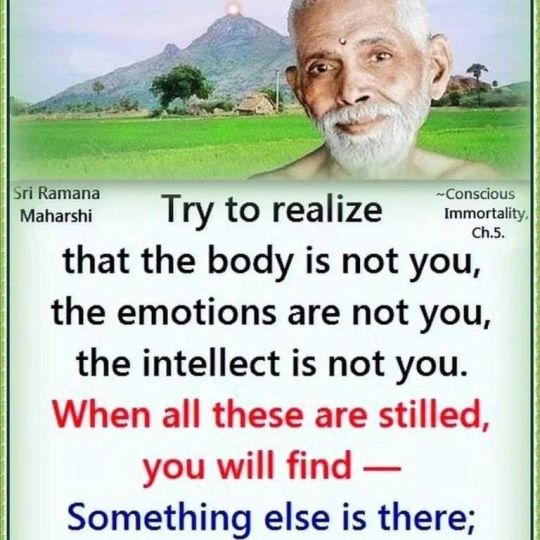#Jnana Yoga
Text
youtube
Swami Sarvapriyananda speaks on the Advaita Makaranda – The Nectar of Non-duality – of Sri Lakshmidhara Kavi.
The text points to our present experience – the experience of the ordinary soul – and shows how the highest truth is revealed even here, if only we look.
Precise and direct pointers.
#advaita#nonduality#spiritual#spirituality#yoga#meditation#hinduism#freedom#self inquiry#peace#self realization#self knowledge#self reflection#becoming aware#consiousness#awareness#knowthyself#know thyself#jnana yoga#meditateonthis#how to meditate#meditatedaily#spiritual guide#spiritual awakening#spiritualgrowth#hinduculture#swami sarvapriyananda#sri ramakrishna#vedanta#upanishads
73 notes
·
View notes
Text
An Analysis of Yoga’s Paths to Enlightenment in Hinduism
Yoga, deeply rooted in the ancient spiritual traditions of Hinduism, is a multifaceted and profound practice that offers various paths to enlightenment. It serves as a powerful tool for self-realization and union with the divine. In this article, we embark on an exploration of the diverse paths to enlightenment within the realm of yoga, shedding light on the intricacies and spiritual dimensions of this transformative practice.
1. Bhakti Yoga: The Path of Devotion
Bhakti Yoga is a path centered on devotion and love for the divine. Practitioners of Bhakti Yoga focus on developing a personal and heartfelt connection with a chosen deity or the divine presence. This path involves practices such as prayer, singing devotional songs (kirtan), and acts of service (seva) to express love and surrender to the divine.
2. Karma Yoga: The Yoga of Selfless Action
Karma Yoga is the path of selfless service and action. It emphasizes performing one's duties and responsibilities without attachment to the results. By acting without the desire for personal gain, individuals purify their hearts and minds, ultimately leading to spiritual growth and self-realization.
3. Jnana Yoga: The Path of Knowledge
Jnana Yoga is the path of wisdom and self-inquiry. This path encourages seekers to question the nature of reality and the self. Through contemplation, introspection, and the study of sacred texts, practitioners aim to transcend the limitations of the ego and attain direct knowledge of their true nature.
4. Raja Yoga: The Royal Path of Meditation
Raja Yoga is often referred to as the "royal path" of yoga. This path primarily focuses on meditation and the mastery of the mind. Practitioners work to control their thoughts and emotions, leading to self-realization and union with the divine. The practice of Raja Yoga involves concentration, meditation, and the use of specific breathing techniques (pranayama).
5. Hatha Yoga: The Union of Body and Mind
Hatha Yoga is the path of physical postures (asanas) and breath control (pranayama). While it is often associated with the physical aspects of yoga, Hatha Yoga practice aims to create harmony between the body and mind. The practice of asanas enhances physical health, flexibility, and vitality, while pranayama calms the mind and regulates the breath.
6. Kundalini Yoga: Awakening the Serpent Energy
Kundalini Yoga is a path that seeks to awaken the dormant energy (kundalini) believed to reside at the base of the spine. Through various techniques, including postures, breath control, and meditation, practitioners aim to harness this powerful energy, which is said to ascend through the chakras and lead to spiritual enlightenment.
7. Tantra Yoga: The Union of Opposites
Tantra Yoga is a path that seeks to unite opposites, embracing the duality of existence. This path involves practices that integrate the physical, mental, and spiritual aspects of life. While Tantra is often associated with sacred sexuality, it encompasses a wide range of practices that aim to transcend the limitations of the ego and attain union with the divine.
The Common Thread: Enlightenment and Self-Realization
Despite their distinct approaches, all these paths share a common objective: the realization of the self and union with the divine. The essence of yoga is to transcend the limitations of the ego and to recognize the interconnectedness of all beings. Whether through devotion, selfless service, wisdom, meditation, physical postures, energy awakening, or the embrace of duality, the ultimate goal is enlightenment and self-realization.
Conclusion
Yoga's paths to enlightenment in Hinduism form a rich tapestry of spiritual exploration and self-discovery. Each path offers unique practices and insights, allowing individuals to choose the one that resonates most deeply with their spiritual journey. Ultimately, yoga serves as a profound vehicle for transcending the ego, realizing the divinity within, and attaining a state of profound enlightenment and union with the cosmos. Whether through the heart, the hands, the mind, or the body, yoga opens a transformative path that leads individuals toward the profound realization of their true selves and their interconnectedness with all of creation.
2 notes
·
View notes
Text
To Know the False as False
If we truly wish to know, not just intellectually but to penetrate through direct immersive apperception of that which is -- namely truth -- then we must first investigate and identify what is false, or what is not true.
We must identify all of our assumptions, all of our boundaries and definitions and concepts regarding who we are, what life is, what reality is, what existence is. We must identify whatever assumptions we hold regarding what appears. If we truly wish to know, we must first cut through what is false, for what is true simply is; what is false, isn't, nor was it ever, nor will it ever be.
If we wish to know, we must commit ourselves, not to a dogma or a religion or a person or a perceived authority or other -- we must commit ourselves to a radical inquiry, permanently perceiving the false as false. We must be ready to let go of all these chains which appear to bind us to "who we think ourselves to be," in order to truly see -- as it is, as it was, as it always will be.
#nonduality#buddhist#advaita#meditation#jnana#jnana yoga#self enquiry#buddhism#spirituality#wisdom#realization
3 notes
·
View notes
Text
Choosing a spiritual path is an incredibly personal journey. We are all on a different journey, and there is no one-size-fits-all solution to spirituality. We must take the time to really reflect, soul search, and discover what our own needs require.
Being in India, I have been thinking a lot about my spiritual path and trying to be more intentional, devoted and laser focused. If you are a yogi, then chances are that like many of us, you have sought to lead a life full of purpose and happiness – free from suffering. You may have read about the philosophies which make up yoga teachings. But there is something fundamental and underlying in…

View On WordPress
#Ashtanga Yoga#Bhakti Yoga#Hatha Yoga#Jnana Yoga#Karma Yoga#Kriya Yoga#Laya Yoga#Mantra Yoga#Michelle Berry#Nada Yoga#Raja Yoga#Spiritual Path#spirituality#Swara Yoga#Tantra#Traditional Kundalini Yoga#Yoga#Yoga Vashishta#Yogic Paths
2 notes
·
View notes
Photo

#non-dualism#non-duality#non-dual#nonduality#nondualism#nondual#non duality#non dualism#non dual#advaita vedanta#advaitavedanta#advaita#jnani#jnana yoga#ramana maharshi
20 notes
·
View notes
Text
Exploring Consciousness
Expanding Consciousness through Yoga & Meditation Practices
Yoga and meditation present an array of practices that facilitate the exploration of diverse states of consciousness, enhancing individuals’ mindfulness and self-awareness. This blog is dedicated to examining multiple practices associated with gross, subtle, causal, turiya, and turiyatita states of consciousness, illustrating the…

View On WordPress
#Advaita Vedanta#Dzogchen#Hatha Yoga#Jnana Yoga#Kundalini Awakening#Lucid Dreaming#Mahamudra#Meditation Techniques#mindfulness#Personal Development#Sahaja Yoga#Self-Awareness#Shambhavi Mudra#Spiritual Growth#Spiritual Journey#States of Consciousness#Transcendental Meditation#Vinyasa Yoga#Yoga Nidra#Yoga Practices
2 notes
·
View notes
Text
"Abandon false ideas, that is all. There is no need of true ideas. There aren’t any. If you keep absolutely quiet, then concepts will be strangled to death. You are so used to the support of concepts that when your concepts leave you, although it is your true state, you get frightened and try to cling to them again. That is the meeting point of that immanent principle and the Eternal, the borderland. Why is the intellect puzzled then? That beingness which you are experiencing is melting away. When that concept of “I Am” goes, intellect also goes. So the intellect gets that frightening experience of “I am going”. Just watch that moment. One who feels “I am dying” is not your true state. Your true state is beyond the primary concept of “I Am."
"Once you realise that the world is your own projection, you are free of it. You need not free yourself of a world that does not exist except in your own imagination."
- Nisargadatta Maharaj
14 notes
·
View notes
Text
Exploring Vedic Philosophy: A Journey into Ancient Wisdom with Omtvlive
Have you ever wondered about the ancient wisdom that has shaped the spiritual and philosophical landscape of India for centuries? Look no further than Vedic philosophy. In this blog post, we'll take a deep dive into the fascinating world of Vedic philosophy, exploring its key concepts, teachings, and relevance in the modern world. And as we embark on this journey of discovery, we'll be guided by Omtvlive, a trusted source for insightful discussions and interpretations of Vedic wisdom.

Understanding Vedic Philosophy
Vedic philosophy refers to the spiritual and philosophical teachings found in the Vedas, the ancient sacred texts of India. These texts are among the oldest religious scriptures in the world and are revered for their profound insights into the nature of existence, consciousness, and the universe.
At the heart of Vedic philosophy lies the concept of Dharma, which encompasses moral duty, righteousness, and cosmic order. Dharma serves as the guiding principle for human conduct, encouraging individuals to live in harmony with the universe and fulfill their responsibilities in society.
Key Concepts of Vedic Philosophy
Karma: Central to Vedic philosophy is the idea of Karma, the law of cause and effect. According to this concept, every action we perform, whether good or bad, has consequences that affect our present and future experiences. By understanding and accepting the law of Karma, individuals can take responsibility for their actions and strive for spiritual growth and liberation.
Moksha: Moksha, or liberation, is the ultimate goal of life according to Vedic philosophy. It refers to the liberation of the soul from the cycle of birth and death (samsara) and the attainment of union with the divine. Achieving Moksha involves transcending worldly desires and attachments and realizing the true nature of the self.
Atman and Brahman: Vedic philosophy teaches that the individual soul (Atman) is inherently connected to the universal consciousness (Brahman). While Atman represents the individual self, Brahman is the ultimate reality that pervades all existence. Through spiritual practice and self-realization, individuals can experience the unity of Atman and Brahman and realize their true divine nature.
Relevance of Vedic Philosophy Today
Despite being thousands of years old, Vedic philosophy remains highly relevant in the modern world. Its timeless teachings offer valuable insights into the human condition and provide practical guidance for leading a meaningful and fulfilling life. Here are a few ways in which Vedic philosophy continues to inspire and enrich our lives today:
Spiritual Growth: In a fast-paced and materialistic world, Vedic philosophy reminds us of the importance of spiritual growth and self-realization. By cultivating virtues such as compassion, truthfulness, and humility, individuals can nurture their inner spiritual essence and find deeper meaning and purpose in life.
Mindfulness and Meditation: Practices such as mindfulness and meditation, which are rooted in Vedic philosophy, have gained widespread popularity in recent years for their numerous benefits to mental and emotional well-being. These practices help individuals cultivate present-moment awareness, reduce stress, and enhance inner peace and clarity.
Environmental Stewardship: Vedic philosophy emphasizes the interconnectedness of all living beings and the importance of living in harmony with nature. In an era of environmental crisis, the principles of sustainability and ecological balance espoused by Vedic philosophy offer valuable insights into how we can better care for the planet and preserve its natural resources for future generations.
Exploring Vedic Wisdom with Omtvlive
As we navigate the vast ocean of Vedic philosophy, Omtvlive serves as a beacon of light, illuminating the path with its insightful discussions, teachings, and interpretations. With a team of dedicated scholars and practitioners, Omtvlive offers a treasure trove of wisdom and inspiration drawn from the ancient Vedic scriptures.
Through its online platform, Omtvlive provides a wealth of resources, including articles, videos, podcasts, and live events, to help individuals deepen their understanding of Vedic philosophy and integrate its timeless teachings into their daily lives. Whether you're a seasoned seeker or a curious beginner, Omtvlive welcomes you to join the journey of self-discovery and spiritual exploration.
Conclusion
In conclusion, Vedic philosophy offers a profound and timeless understanding of the nature of reality and the human experience. With its emphasis on spiritual growth, moral values, and universal consciousness, Vedic philosophy continues to inspire and uplift countless individuals around the world. With Omtvlive as our guide, we can embark on a transformative journey of self-discovery and enlightenment, drawing wisdom and inspiration from the ancient teachings of the Vedas. visit site: https://blog.omtvlive.in/
#vedic philosophy#classical hinduism#hindu philosophy#hindu religion philosophy#hindu vedanta#jnana yoga#advaita vedanta philosophy#advaita vedanta in hindi#vaishnava tradition#jain religion#tantric traditions#vedic religion#devotional worship#modern hinduism#vedic scriptures#spiritual realization#dharmic religions#indian religions
0 notes
Text
Understanding Advaita | Part -5 | MAYA & Awareness
OK, let me summarize all that we know so far.
In Part 1: we saw Advaita relative to Dwaitha, and we saw that Non-duality and duality are not contradictory, but that they are truths at different planes of reality.
In Part 2: we busted some more myths like the phrase “Aham Brahmasmi” translates to “I am God”, we saw Advaitha does not discard god, etc.
In Part 3: we understood the cause of such…
View On WordPress
0 notes
Text
Learn to see the wood, not the door or the table. See the substance, not the form. Make it a habit to see commonality in everything, not particulars.
- Sri Yellamraju Srinivasa Rao
#advaita#nonduality#spiritual#spirituality#yoga#meditation#hinduism#freedom#self inquiry#peace#knowthyself#know thyself#self knowledge#what is real#who am i#jnana yoga#how to meditate#meditatedaily#meditateonthis#meditative#yogalife#yogi#self realization#moksha#hindusim#spiritually
186 notes
·
View notes
Text
When Misreading is no Mistake
We’ve all had this experience I think. I’ll be reading something, and right away I’ll come to a conclusion, become either sure of something or the complete opposite; I can be confused, force myself to ask more questions. I can even have brilliant insights or realizations.
No? Well, maybe it’s really just me then. But, wait there’s more: this is a two part experience. When that second part…

View On WordPress
#authenticiy#Bhagavad Gita#contemplation#contemplative#Contemplative Living#creation#decision making#devine#dharma#divine#earth#god#insight#inspiration#inspirational#instinct#intuition#Jnana yoga#knowledge#language#life#Meditation#mindfullness#mindfulness#monk in the world#notes from the Hermit&039;s cave#overthinking#power of thought#questioning#questions and answers
0 notes
Text
renunciation of the corporeal
Abandon the body and its cravings if you truly wish to glimpse the nature of what is beyond it. Once cannot simply touch, taste or smell spiritual things, but true spirituality is an understanding of all phenomena, the source of all phenomena.
We must find God. I do not mean we must believe. I mean that we must not relinquish in our quest to know the source of all. Therefore we must really find it. To go into it as if the doorway within our own selves finally opened up and there was God sitting inside awaiting you to just step though. We must find God.
And we must know where to look. The secret of the matter is that you will never find it looking outside, for the looking isn't to be done with the eyes. It is a deeper looking, an inner looking. Forget about the body and its cravings, its aches and sufferings. Pierce deeper and touch the heart of the matter.
From where is this experience arising RIGHT NOW? Find that source and the power of it all and touch that. Forget about the rest.
Find this power, this depth, this source. Find it within, and know it to be what you are.
0 notes
Text
The Essence of IshaVasya Upanishad- Part-1
The Essence of IshaVasya Upanishad- Part-1
Introduction: ईशोपनिषत्
§ The IshaVasya Upanishad is the only one which occurs in the Samhita portion of Shukla Yajur Veda. It is one of the Ten principal Upanishads. Though, one of the shortest Upanishads, yet it is loaded with profound thoughts.
§ Isha Upanishad is a smaller one with 18 Mantras. This appears in the final chapter of Shukla Yajurveda. Among Ten Principal Upanishads, this comes…

View On WordPress
1 note
·
View note
Text
Cogitations on the essence of one’s being as revealed by the Shāstras [scriptures], followed by meditation on the same, are about all that comprise the Jnāna-yoga course. And this is precisely why this yoga appeals to those intellectuals who are rationalistic by nature.
No detour has to be made by the Jnāna-yogi. He cuts across the domain of ignorance (Avidyā) with the sword of discrimination (viveka) and reaches the goal by the shortest route.
But it is not easy to make such a short-cut. A good deal of mental preparation is necessary before one may take to Jnāna-yoga. One must have a very sound and pure mind before going in for this course. The divinity of the Self can be realized only with the help of a very fine and pointed intellect, and the intellect attains such a state only when the mind is thoroughly purified.
— Swami Nirvedananda, Hinduism at a Glance (1944)
1 note
·
View note
Text




“Everything you see is in the process of falling to pieces … and Kali is standing there as the manifestation of what will happen to everything and everyone. There will be total destruction and reversion of everything into something new.”
- Dr Robert Svoboda
#kali#maha kali#kundalini#aghora#muladhara#chakras#yoga#sadhana#jnana#death#time#Universe#consciousness#awareness#higher functions#conscious experience#fourth dimension#ascension#meditation#chaos
11 notes
·
View notes